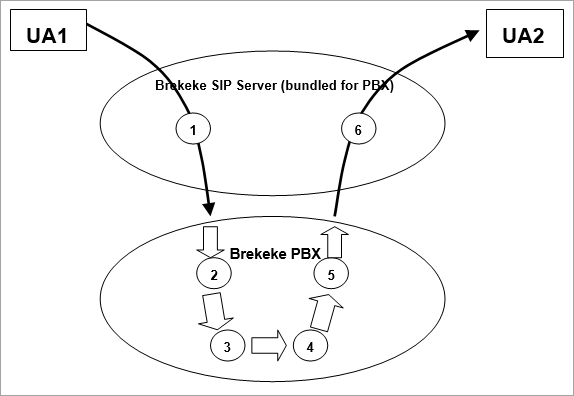SIP Server Relationships
A SIP server is embedded in Brekeke PBX. If you log in to Brekeke PBX as an Administrator, you can also access and manage the bundled SIP server. The bundled SIP server is a SIP proxy server which provides call session management in a VoIP network and processes SIP requests and responses. When Brekeke PBX receives a call session, it initiates another session with the appropriate destination according to the user settings, such as assigned phones and forwarding destinations, and then joins the two sessions.
1. Default Dial Plans in the Bundled SIP Server
The bundled SIP server has the following default settings in the Dial Plan:
From PBX
This dial plan rule will apply to a session coming from Brekeke PBX that does not match the Dial Plan rules above it. It will disable Authentication and send the call to its destination.
To PBX from ITSP
All sessions from ITSP or SIP gateway devices with a localhost registration record will be routed to Brekeke PBX. B2BUA mode will be set to “true” and Authentication will be set to “false.”
To PBX
Sessions that are initialized from registered UAs will be routed to Brekeke PBX with UDP transport and without Authentication checking.
Subscribe
All SUBSCRIBE requests for Message Waiting Indicator (MWI), Presence, BLF, SCA and for Multiline functions of SAXA IP Phones will be routed to Brekeke PBX.Thru Register
REGISTER requests from Brekeke PBX will be applied when Brekeke PBX is registering to a third-party SIP proxy server using Thru Registration. When a third-party SIP proxy server has a global IP address and the bundled SIP server does not have an interface for the global IP address, the bundled SIP server will not send a REGISTER request to the third-party SIP proxy server. This is to prevent problems with ITSPs since having a local IP address registered at an ITSP’s proxy server tends to cause problems.
Register Behind NAT
This dial plan is disabled by default. Edit and enable it to solve NAT issues for registration from some UAs. Also remove the underscore in either ®ister.contact.nat=true or &net.registrar.adjust.expires=10.
2. Call Process Flow
In this section, we give a step-by-step explanation of how a call from UA1 to UA2 is processed.

The following items describe the steps in the above image:
- The call initiated by UA1 matches with the Dial Plan rule “To PBX” at the bundled SIP server and is routed to Brekeke PBX.
- When Brekeke PBX receives the call, it searches for an ARS “Pattern IN” that matches with the call. If Brekeke PBX finds a pattern, it will change the caller’s address (From) and call recipient’s address (To) as specified in the Deploy Patterns.
- If the “To” header includes a prefix for Call Pickup, Park Pickup or for accessing an existing call, Brekeke PBX will join this call with the corresponding existing call. If not, Brekeke PBX will treat this call as a new call.
- Brekeke PBX will check the settings in [Users] > [Inbound] to determine the call destination. If multiple destinations are set in the [Users] > [Inbound] > [Forward To] section or an extension is set in the [Users] > [Settings] > [Automatic Monitoring*] field, Brekeke PBX will process the call routings for multiple destinations in parallel with Step 5.
- Brekeke PBX searches for an ARS “Pattern OUT” that matches the call. If Brekeke PBX finds a pattern, it will change the caller’s address (From) and call recipient’s address (To) as specified in the Deploy Patterns.
- The call is processed by the bundled SIP server’s Dial Plan feature and routed to UA2.
